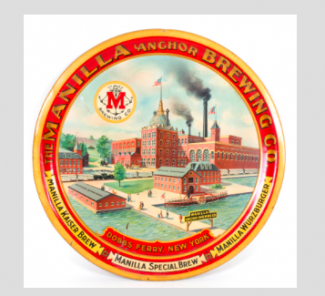by Mike Hays

Otto Hahn in the early 1900s in front of his saloon with the ad for Manilla Lager Beer front and center. The building is now home to the Upper Nyack Village hall.
There’s a photo from 1900 of the saloon owner Otto Hahn standing proudly on his porch beneath a large sign advertising Manilla Lager Beer. Nyack residents may recognize the building in the picture, as it’s now Upper Nyack’s Village Hall. Upper Nyack “downtown” was still a bustling center a century ago, so the saloon, next door to the firehouse, was a convenient place to gather. Other taverns in Nyack, like J. R. Crowleys tap in South Nyack, carried the same advertising banner. Manilla lager was so popular that come winter, barrels would be shipped from Westchester to Nyack by sled across the frozen Ice Bridge on the Hudson River.
Manilla Lager is now a forgotten brand, leaving us with nothing but questions and memorabilia. Why was it Nyack’s most popular brand at the time? What would our current brew-pubs and craft breweries think of Manilla Lager? And crucially, if it was so popular, why did it disappear?
The lager is born
 Early American immigrants drank a number of fermented drinks: whiskey, rum, cider, wine, and ale. Scientists have even uncovered evidence that the Pueblo Native Americans made a fermented corn “beer.” Ale was preferred in colonial times since it is quick to make, tolerates higher temperatures, and travels well. Lighter, German-style lagers didn’t appear until around the 1840s in Europe and in America. (Prior to 1840, a steam style of lagers were made.)
Early American immigrants drank a number of fermented drinks: whiskey, rum, cider, wine, and ale. Scientists have even uncovered evidence that the Pueblo Native Americans made a fermented corn “beer.” Ale was preferred in colonial times since it is quick to make, tolerates higher temperatures, and travels well. Lighter, German-style lagers didn’t appear until around the 1840s in Europe and in America. (Prior to 1840, a steam style of lagers were made.)
Refrigeration made these brews possible. German immigrants to America brought the lighter style technique to America, and soon lager was widely available as commercial refrigeration and pasteurization methods developed. By the 1890s, the light, fresh, and bubbly lager was more popular than ale. Railroads provided a quick avenue for distribution and lager became widely available.
Rockland Breweries in the 19th century

The Rockland Brewery
Rockland County was not known for its breweries in the 19th century. The Rockland Brewery was located on the eponymous Brewery Road in New City. It wasn’t successful. By 1880, the building was a vinegar and wine factory; by the 20th century, it was a summer resort called the French Farm.
In Nyack, an 1852 map indicates that a very early brewery, The Firth of Forth Brewery, was located on the Upper Nyack Brook near present-day Nyack High School.
The Biegan and the Anchor Brewing Companies

1897 calendar of Anchor Brewing Company. Note the large factory in Dobbs Ferry shown in the background.
Brewing was a big business in Westchester by the mid-1800s, especially with the arrival of German immigrants. In 1856, Pieter Biegan started a small brewery in Dobbs Ferry, located at 145 Palisade Street. The brewery complex contained a pool, waterfall, and underground storage areas. Biegan Brewery lager became well known because the brewing water came from a Wicker’s Creek collect pond that was of exceptional flavor and purity. The company became successful when it started winter shipment of beer to Nyack. By 1866, the Anchor Brewing Company had taken over and expanded the business.
The Manilla Anchor Brewing Company
In 1900, the Anchor Brewing Company became the Manilla Anchor Brewing Company with a well-known brewer from Germany, Selig Manilla, as principal owner and president. The beer brand was renamed, as was the company name. The brewery grew to five stories in height, covering nine acres with a capacity of 100,000 barrels of lager beer. The opening of the plant was celebrated with a giant clambake attended by 1,500 people from New York and New England.
 A brief biography of Selig Manilla: businessman, brewer, politician
A brief biography of Selig Manilla: businessman, brewer, politician
Manilla was born in Germany to Jewish parents, and learned the brewing business In Berlin. He moved to New York City and started the Abbot Brewing company in Brooklyn, along with making Democratic party connections to Tammany Hall. By the late 1880s, he moved to Springfield MA, opening Springfield Brewing Company, the highly successful company that revolutionized the brewing process in New England while producing 70,000 barrels a year. During Manilla’s stay in Massachusetts, he was elected as a delegate to the 1896 Democratic Convention that nominated William Jennings Bryan for President. By 1900, he was back in New York, forming the Manilla Anchor Brewing Company, which he managed until his death in 1907. The company didn’t survive Prohibition; it closed in 1920.
Nyack’s favorite lager

Crowley’s Tavern in South Nyack in the early 1900s with its Manilla lager sign.
Otto Hahn wasn’t alone in pumping Manilla lager in his Upper Nyack saloon. John Crowley S.’s saloon in South Nyack, at the corner of Willow and Franklin streets (now located in the middle of the Thruway), also sported a large Manilla Lager sign above its front door. Manilla was the Hudson River’s finest brew at the time.
Local beer lovers rue the loss of this once famous local lager that now exists in limited quantities of memorabilia prized by collectors. Undoubtedly, time has also changed the magical waters of Wicker Creek in Dobbs Ferry. Our local beer lovers can only dream that this once prized lager was now available Nyack’s current tap houses.
See also
Photo credits: Photos courtesy of the Nyack Library
Michael Hays is a 30-year resident of the Nyacks. Hays grew up the son of a professor and nurse in Champaign, Illinois. He has recently retired from a long career in educational publishing with Prentice-Hall and McGraw-Hill. Hays is an avid cyclist, amateur historian and photographer, gardener, and dog walker. He has enjoyed more years than he cares to count with his beautiful companion, Bernie Richey. You can follow him on Instagram as UpperNyackMike.

 Nyack People & Places, a weekly series that features photos and profiles of citizens and scenes near Nyack, NY, is brought to you by HRHCare and Weld Realty.
Nyack People & Places, a weekly series that features photos and profiles of citizens and scenes near Nyack, NY, is brought to you by HRHCare and Weld Realty.







